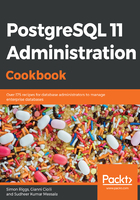
上QQ阅读APP看书,第一时间看更新
How to do it…
The most basic method is to use the psql tool. The \password command will prompt you once for a new password and again to confirm. Connect to the psql tool and type the following:
SET password_encryption = 'scram-sha-256';
\password
Enter a new password. This causes psql to send a SQL statement to the PostgreSQL server, which contains an already encrypted password string. An example of the SQL statement sent is as follows:
ALTER USER postgres PASSWORD 'SCRAM-SHA-256$4096:H45+UIZiJUcEXrB9SHlv5Q==$I0mc87UotsrnezRKv9Ijqn/zjWMGPVdy1zHPARAGfVs=:nSjwT9LGDmAsMo+GqbmC2X/9LMgowTQBjUQsl45gZzA=';
Make sure you use SCRAM-SHA-256 encryption, not the older and easily compromised md5 encryption. Whatever you do, don't use postgres as your password. This will make you vulnerable to idle hackers, so make it a little more difficult than that!
Make sure you don't forget your password either. It may prove difficult to maintain your database if you can't access it.